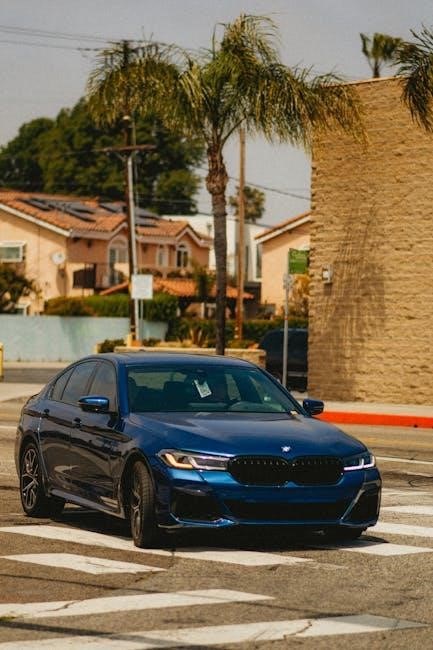California temporary license plates provide a short-term solution for vehicle operation while permanent plates are processed․ They are essential for new purchases‚ ensuring legal compliance on roads․
1․1․ Definition and Purpose
A California temporary license plate is a short-term permit issued by the DMV‚ allowing legal vehicle operation while permanent plates are processed․ It serves as proof of registration and ensures compliance with state laws․ Temporary plates are typically valid for 30 to 90 days‚ providing immediate authorization to drive a newly purchased or unregistered vehicle․ They are essential for maintaining legal status on public roads during the transition to permanent registration․
1․2․ Legal Requirements
To obtain a California temporary license plate‚ specific legal requirements must be met․ The vehicle must be registered with the DMV‚ and all applicable fees‚ including registration and titling costs‚ must be paid․ Temporary plates are issued only for vehicles that are awaiting permanent registration or for new purchases․ They must be displayed on the rear of the vehicle and are valid only for the specified period․ Driving without a valid temporary plate can result in fines and penalties‚ emphasizing the importance of compliance․
1․3․ Validity Period
California temporary license plates are typically valid for a limited duration‚ usually 30 to 90 days‚ depending on the type of permit․ This period allows sufficient time for the processing and issuance of permanent plates․ The exact validity is printed on the temporary plate and must be adhered to․ Exceeding the validity period without obtaining permanent registration can lead to legal consequences‚ including fines․ It is crucial to monitor the expiration date and complete the registration process promptly to avoid penalties․
Obtaining a California Temporary License Plate
Temporary plates are issued by the California DMV‚ allowing legal vehicle operation while permanent plates are processed․ They are typically valid for 30 to 90 days․
2․1․ Application Process
To obtain a California temporary license plate‚ visit the DMV or access their online platform․ Fill out the application form‚ providing vehicle details such as the VIN․ Submit required documents‚ including proof of purchase or insurance․ Pay the applicable fees online or in person․ Once processed‚ you’ll receive a temporary plate‚ either as a printable PDF or a paper permit․ Ensure all information is accurate to avoid delays or issues․
2․2․ Required Documentation
To apply for a California temporary license plate‚ you must provide specific documentation․ This includes a completed Report of Sale (ROS)‚ proof of vehicle insurance‚ and a valid government-issued ID․ Additionally‚ the vehicle’s title or a copy of the sales contract may be required․ Ensure all documents are up-to-date and accurately reflect the vehicle’s details․ Proper documentation ensures a smooth application process and prevents delays in obtaining the temporary plate․
2․3․ Fees and Payment Methods
The California DMV charges a fee for issuing temporary license plates‚ typically around $25‚ covering a 30- to 90-day period․ Payment can be made via cash‚ credit card‚ or check․ Online applications may offer additional payment options․ Ensure the fee is paid in full to avoid delays․ Fees are non-refundable and may vary based on specific circumstances․ Always verify current rates and acceptable payment methods with the DMV before submitting your application․
Design and Format of Temporary License Plates
California temporary plates follow a standardized design‚ including alphanumeric characters‚ security features‚ and official DMV templates․ They ensure authenticity and prevent fraud‚ adhering to state regulations strictly․
3․1․ Official DMV Template
The California DMV provides an official template for temporary license plates‚ ensuring uniformity and compliance with state regulations․ This template includes specific fonts‚ layouts‚ and security features to prevent fraud․ It specifies the placement of the vehicle identification number (VIN)‚ expiration date‚ and other essential details․ The template is available as a downloadable PDF‚ allowing users to print temporary plates instantly after completing the registration process online․ This ensures a smooth transition while awaiting permanent plates․
3․2․ Alpha-Numeric Structure
California temporary license plates follow a standardized alpha-numeric structure to ensure clarity and traceability․ The format typically includes a combination of letters and numbers‚ with the first two characters being letters and the remaining characters being numbers․ For example‚ plates may start with “TMP” followed by a series of digits․ This structure helps in maintaining uniformity and makes it easier for law enforcement to identify and verify temporary plates․ The alpha-numeric system also prevents fraud by ensuring each plate is unique and easily trackable․
3․3․ Security Features
California temporary license plates incorporate advanced security features to prevent tampering and counterfeiting․ These include watermarks‚ holograms‚ and unique serial numbers․ The plates are made of durable paper with a tamper-evident design‚ ensuring any alteration is visible․ Additionally‚ a state-specific logo and magnetic strips enhance authenticity․ These features help law enforcement verify the legitimacy of temporary plates efficiently‚ maintaining road safety and compliance with state regulations․ The security measures are regularly updated to stay ahead of potential fraud threats․

Temporary Operating Permit (TOP)
A Temporary Operating Permit (TOP) allows short-term vehicle operation when registration is pending․ Issued by the California DMV‚ it ensures compliance until permanent plates are received․
4․1․ When a TOP is Issued
A Temporary Operating Permit (TOP) is issued when all registration fees are paid‚ but the license plates or registration stickers haven’t been received․ It serves as a temporary solution‚ allowing legal vehicle operation for a short period․ Typically valid for 30 days‚ the TOP ensures compliance with state regulations while the permanent registration is processed․ It is crucial for individuals awaiting their official plates to avoid penalties and maintain legal driving privileges in California;
4․2․ Duration of Validity
A Temporary Operating Permit (TOP) in California is typically valid for 30 days from the date of issuance․ This period allows sufficient time for the permanent license plates and registration stickers to be processed and delivered․ The TOP ensures legal vehicle operation during this transitional phase and must be displayed prominently on the vehicle․ It expires automatically once the permanent registration is completed‚ and any extension requires reapplication through the DMV․

4․3․ Application Process for TOP
To obtain a Temporary Operating Permit (TOP) in California‚ applicants must complete form REG 402 and provide required documentation‚ such as proof of registration payment and vehicle identification details․ The application can be submitted in person at a DMV office or through a licensed service provider․ A fee is applicable‚ and the permit is issued immediately upon approval․ This process ensures vehicles can operate legally while awaiting permanent registration materials․
Special Cases and Exemptions
Special cases include non-resident vehicles‚ dealer-issued plates‚ and certain exemptions for specialized vehicles․ These cases follow specific DMV rules to ensure compliance and legal operation․

5․1․ Non-Resident Vehicles
Non-resident vehicles in California may operate with their home state license plates for a limited period․ Temporary permits are available for non-residents needing extended stays․ These permits ensure compliance with California vehicle codes while allowing legal operation during the transition․ Specific documentation‚ such as proof of residency and insurance‚ may be required․ Non-resident vehicles are generally exempt from certain registration fees‚ provided they adhere to the designated timeframe for temporary use․
5․2․ Dealer Issued Temporary Plates
Dealers in California often issue temporary license plates for newly purchased vehicles․ These plates are valid for up to 90 days‚ allowing time for permanent registration․ Dealers must follow strict DMV guidelines when issuing these plates‚ ensuring all necessary information‚ such as the vehicle’s VIN and sale details‚ is included․ This temporary permit is crucial for buyers to legally operate their new vehicle immediately after purchase while awaiting official plates․
5․3․ Exemptions for Certain Vehicles
California offers exemptions for specific vehicles‚ such as non-resident vehicles and certain dealer-issued plates․ These exemptions allow temporary operation without permanent registration․ For example‚ out-of-state vehicles may use their home state plates temporarily․ Additionally‚ vehicles sold by dealers may receive exemptions under specific conditions․ These exemptions ensure flexibility for drivers transitioning to permanent registration‚ aligning with DMV regulations and facilitating compliance without unnecessary delays or penalties․

Common Issues and Solutions
Common issues include lost‚ stolen‚ or expired plates․ Solutions involve reporting incidents to the DMV‚ applying for replacements‚ and ensuring compliance to avoid penalties and legal issues․
6․1․ Lost or Stolen Temporary Plates
If a temporary plate is lost or stolen‚ report it immediately to the California DMV․ File a report with local law enforcement and obtain a copy․ Visit the DMV with the report and proper identification to apply for a replacement․ A small fee may apply․ Ensure the vehicle remains operational by securing a new temporary plate promptly to avoid legal consequences and maintain compliance with state regulations․
6․2․ Expired Temporary Plates
Driving with an expired temporary plate is illegal and may result in fines or penalties․ If your temporary plate expires‚ contact the California DMV immediately to obtain a new one․ You may need to provide proof of registration and pay a fee․ In some cases‚ a Temporary Operating Permit (TOP) can be issued if you’ve already paid registration fees․ Ensure compliance by renewing or replacing expired plates promptly to avoid legal consequences and maintain valid vehicle operation․
6․3․ Incorrect Information on Temporary Plates
If your California temporary license plate contains incorrect information‚ contact the DMV immediately․ Submit a corrected application with proper documentation‚ such as proof of ownership or updated registration details․ A replacement plate may be issued after verification․ Ensure all details‚ including VIN and vehicle description‚ are accurate to avoid legal issues․ Correcting errors promptly maintains compliance and prevents potential penalties or delays in obtaining permanent plates․

Compliance and Enforcement
Compliance with California temporary license plate regulations is mandatory․ The DMV enforces strict guidelines to ensure legal vehicle operation‚ maintaining road safety and proper documentation standards statewide․
7․1․ Consequences of Non-Compliance
Non-compliance with California temporary license plate regulations can result in fines‚ legal penalties‚ and vehicle impoundment․ Driving without valid temporary plates may lead to citations and increased insurance costs․ Additionally‚ failure to display proper documentation can delay vehicle registration and may result in suspended driving privileges․ Authorities enforce these rules strictly to maintain road safety and legal standards‚ ensuring all vehicles operate within state guidelines․ Violations can escalate legal consequences‚ emphasizing the importance of adherence․
7․2․ Law Enforcement Procedures

Law enforcement in California verifies temporary license plates through electronic databases and visual inspections․ Officers check for validity‚ ensuring plates match vehicle registration records․ If a temporary plate is expired or unverifiable‚ they may issue citations or impound the vehicle․ Police use automated number plate recognition (ANPR) systems to detect non-compliant plates efficiently․ Drivers found operating without valid temporary plates face penalties‚ emphasizing strict enforcement to maintain road safety and legal compliance․ Proper documentation is essential to avoid legal actions․
7․3․ Reporting Violations
Violations related to California temporary license plates can be reported to the DMV or local law enforcement․ Citizens can submit reports online or through mobile apps‚ providing plate details and violation evidence; Anonymous reporting is also an option․ The DMV investigates these reports to ensure compliance‚ addressing issues like expired plates or improper usage․ Prompt reporting helps maintain road safety and accountability‚ ensuring all vehicles operate legally within state regulations․ Public participation is encouraged to uphold traffic laws effectively․
Digital and PDF Templates
California temporary license plate templates are available in digital and PDF formats‚ offering convenience for users․ Official DMV templates ensure compliance with state design standards‚ while third-party options provide customizable solutions․ These templates include essential details like plate numbers‚ VIN‚ and expiration dates‚ streamlining the process for temporary plate creation․ Proper printing on durable materials is crucial to maintain readability and avoid violations․
8․1․ Official DMV PDF Templates
Official California DMV PDF templates for temporary license plates are standardized and widely available․ These templates include specific details such as plate numbers‚ VIN‚ and expiration dates‚ ensuring compliance with state regulations․ They are designed to be easily printable and meet legal requirements for temporary vehicle operation․ The DMV provides these templates to streamline the process for users‚ ensuring clarity and readability․ They are accessible on the official DMV website or at local DMV offices‚ offering a reliable source for temporary plate creation․
8․2․ Third-Party Templates

Third-party templates for California temporary license plates are available online‚ offering convenience for users․ These templates often mimic the official DMV format but are created by external sources․ While they can save time‚ users must ensure they meet DMV standards to avoid legal issues․ Third-party templates typically include spaces for essential details like plate numbers‚ VIN‚ and expiration dates․ However‚ their validity depends on compliance with state regulations‚ and users are cautioned to verify their accuracy before use to prevent potential penalties or enforcement actions․
8․3․ Printing and Usage Guidelines
California temporary license plate templates must be printed on standard paper using black ink for clarity․ Ensure the template is printed on both sides to prevent alteration․ The temporary plate must be displayed on the rear of the vehicle and remain legible․ Users should avoid laminating the paper to maintain its temporary nature․ Digital templates are available‚ but only the printed version is valid for vehicle operation․ Always follow DMV guidelines to ensure compliance and avoid legal issues․

Vehicle Registration Process
The California vehicle registration process involves obtaining permanent plates after temporary ones expire․ Transitioning from temporary to permanent requires submitting documentation and fees‚ with renewals done annually․
9․1․ Permanent Registration
Permanent registration in California follows the expiration of temporary license plates․ It involves submitting required documents‚ such as proof of ownership and insurance‚ and paying registration fees․ Once processed‚ a durable‚ official license plate is issued‚ featuring enhanced security elements․ Permanent registration is typically valid for one year‚ after which renewal is required․ This process ensures continuous compliance with state vehicle regulations‚ maintaining legal operation of the vehicle on public roads․
9․2․ Transition from Temporary to Permanent Plates
The transition from temporary to permanent plates involves submitting required documents and fees to the California DMV․ Once processed‚ the temporary plate is replaced with a durable‚ official license plate․ This transition typically occurs within 30 to 90 days‚ depending on processing times․ The permanent plate includes enhanced security features and is valid for a specified period before renewal is required․ Proper documentation‚ such as proof of ownership and insurance‚ must be provided to complete the transition smoothly․
9․3․ Renewal Process
The renewal process for California license plates is a straightforward procedure that ensures continued vehicle operation․ Vehicle owners typically receive a renewal notice annually‚ which can be completed online‚ by mail‚ or in person․ Required documents include the renewal form‚ proof of insurance‚ and payment of fees․ Upon completion‚ a new registration sticker or plate is issued․ It’s crucial to renew on time to avoid penalties and maintain legal driving status․ Proper documentation and timely payment ensure uninterrupted vehicle registration․

Historical Context
California temporary license plates have evolved since their introduction‚ with designs reflecting historical significance and regulatory changes․ They remain a crucial interim solution for vehicle registration․
10․1․ Evolution of Temporary Plates
California temporary license plates have undergone significant transformations since their inception․ Early versions were simple paper plates‚ often handwritten‚ while modern designs incorporate printed templates with enhanced security features․ The introduction of PDF templates has streamlined issuance‚ allowing for digital generation and printing․ Historically‚ temporary plates were issued by dealers or the DMV‚ with designs reflecting regulatory changes․ Over time‚ they have evolved to include alpha-numeric structures‚ security watermarks‚ and compliance verification․ This evolution ensures temporary plates remain effective interim solutions for vehicle registration․
10․2․ Changes in Regulations
Regulations for California temporary license plates have evolved to enhance security and compliance․ Historically‚ temporary plates were issued on paper with minimal oversight‚ but modern rules require standardized templates and digital verification․ The DMV now mandates specific alpha-numeric structures and security features to prevent fraud․ Recent changes include the adoption of PDF templates for consistency and traceability․ These updates ensure temporary plates align with state and federal standards‚ reducing counterfeit risks and improving law enforcement verification processes․ Regulatory adjustments reflect ongoing efforts to balance convenience with security․
10․3․ Historical Significance
California temporary license plates have historically served as a bridge between vehicle acquisition and permanent registration․ Initially‚ paper plates were issued with minimal design‚ but over time‚ they evolved to include standardized templates․ The introduction of contests for license plate designs‚ like the California Coastal Commission’s initiative‚ added cultural significance․ Today‚ digital PDF templates represent a modern shift‚ ensuring consistency and security․ This evolution reflects the state’s commitment to balancing functional needs with aesthetic and historical value‚ making temporary plates a notable part of automotive history in California․
Future Trends
California is exploring electronic temporary license plates and enhanced digital templates for streamlined registration processes․ These innovations aim to improve security‚ efficiency‚ and user convenience in vehicle registration․
11․1․ Electronic Temporary Plates
California is exploring electronic temporary license plates as a modern solution․ Digital templates would allow temporary plates to be displayed on mobile devices‚ reducing paper waste․ The DMV is considering a system where temporary plates are issued via email or app‚ enabling instant verification by law enforcement․ This innovation aims to streamline the registration process‚ improve efficiency‚ and reduce administrative burdens․ Electronic plates could also integrate with permanent licenses seamlessly‚ enhancing user convenience and compliance․
11․2․ Enhanced Security Measures
Future enhancements to California temporary license plates include advanced security features to prevent counterfeiting․ Digital watermarks‚ embedded QR codes‚ and tamper-evident materials are being considered․ These measures aim to ensure authenticity and traceability‚ reducing fraud․ Additionally‚ integration with DMV databases will enable real-time verification of plate legitimacy․ Enhanced security features will also include anti-tampering elements‚ such as holograms and UV printing‚ ensuring temporary plates meet high standards of integrity and compliance with state regulations․
11․3․ Streamlined Processes
California is moving toward streamlined processes for temporary license plates‚ focusing on digital solutions․ Online applications and instant PDF issuance reduce wait times․ The DMV is integrating digital templates with registration systems‚ ensuring faster processing․ Additionally‚ automated validation checks minimize errors․ These improvements aim to enhance user experience‚ reduce delays‚ and ensure compliance․ Streamlined processes also include real-time updates and electronic notifications‚ making temporary plate issuance more efficient and accessible for residents and dealers alike․


